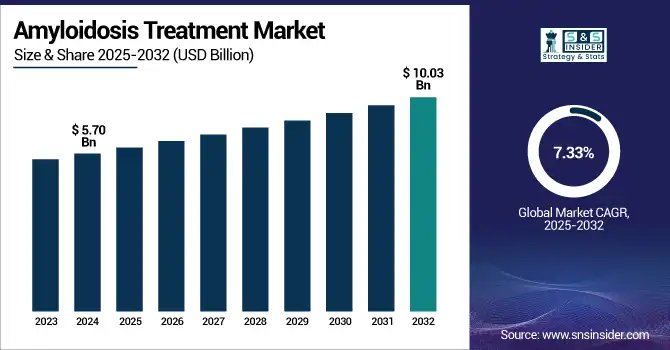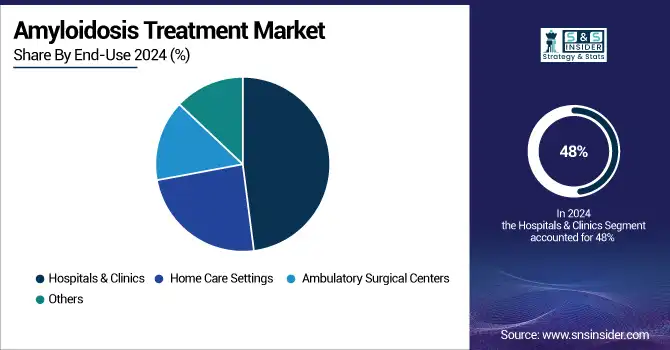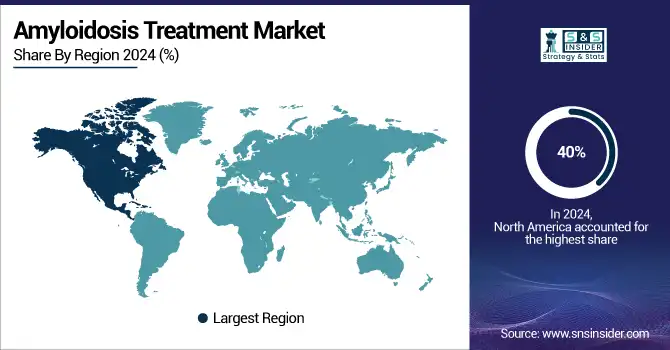Amyloidosis Treatment Market Size Analysis
The Amyloidosis Treatment Market size was valued at USD 5.70 billion in 2024 and is expected to reach USD 10.03 billion by 2032, growing at a CAGR of 7.33% over the forecast period of 2025-2032.

To Get more information on Amyloidosis Treatment Market - Request Free Sample Report
Rising disease prevalence, government investments, and technological innovation are driving rapid growth of the global amyloidosis treatment market. Rare and complicated, amyloidosis is defined by aberrant amyloid protein accumulation in tissues and organs that causes increasing organ dysfunction.
For instance, the most recent U.S. Centers for Disease Control and Prevention (CDC) statistics show that around 4,000 new AL amyloidosis cases are reported yearly in the U.S, suggesting growing illness awareness and enhanced diagnostic capacity.
Funding and regulatory support for rare disease research have been raised by the U.S. Food and Drug Administration (FDA) and National Institutes of Health (NIH), hence accelerating approvals of novel treatments and supporting clinical studies.
Driven by strong healthcare infrastructure, active research, and access to specialist treatment centers, the U.S. amyloidosis treatment market accounted for USD 1.78 billion in 2024 and is predicted to reach USD 3.1 billion by 2032 with a 7.22% CAGR during the forecast period. The NIH and FDA, among other government agencies, have strengthened support for rare disease research, which has accelerated approvals and expanded availability of new treatments. Monoclonal antibodies and gene therapies, among other creative treatments, are transforming the amyloidosis treatment market trends. Major amyloidosis treatment companies such as Pfizer, Johnson & Johnson, Takeda, and Alnylam Pharmaceuticals are in a surge of innovative treatments using strategic collaborations and R&D investments to increase their pipelines. Rising awareness, clinical innovation, and government backing taken together should help to sustain strong amyloidosis treatment market growth in the coming years.
Amyloidosis treatment market analysis indicates that ongoing R&D, regulatory support, and technological innovation are driving the market toward more effective, personalized, and accessible treatments. Amyloidosis is marked by the accumulation of misfolded amyloid proteins, causing organ dysfunction and significant morbidity. Particularly among the elderly, the U.S. CDC notes a consistent rise in amyloidosis-related hospitalizations, therefore underscoring the disease's expanding influence. While the NIH keeps financing clinical research on uncommon diseases such as amyloidosis, the FDA has responded with faster approvals for innovative treatments. Early identification and action resulting from public health campaigns and better diagnostic techniques have together with developments in imaging and biomarker analysis, these government programs are promoting earlier diagnosis and improved patient outcomes, therefore influencing the changing scene of the amyloidosis treatment Market.
Amyloidosis Treatment Market Dynamics
Drivers
-
Regulatory Approvals and Breakthrough Clinical Trials Propel Therapeutic Innovation and Market Growth
Targeted therapy development is being accelerated by recent regulatory milestones and advanced clinical studies, therefore changing the paradigms of amyloidosis treatment.
For instance, based on the HELiOS-B trial, which showed a 28% reduction in cardiovascular mortality and 35% lower hospitalization rates than a placebo, the U.S. FDA authorized Alnylam's AmvuttraTM (vutrisiran) for transthyretin amyloid cardiomyopathy (ATTR-CM) in March 2025.
In April 2025, the European Medicines Agency (EMA) extended Amvuttra's indication to encompass wild-type and inherited ATTR-CM, therefore increasing access throughout EU member states. Concurrently, the ANDROMEDA trial for daratumumab paired with CyBorD attained a 92% hematologic response rate in AL amyloidosis patients, with 78% reaching full remission, therefore placing it as a first-line treatment. Completing enrollment in 2025, the ATTRIBUTE-CM Phase 3 trial for AG10, a TTR stabilizer, supports these developments and seeks to prove its efficacy in preventing amyloidogenesis.
Parallel developments in diagnostics, including amyloid-specific PET tracers and AI-enhanced imaging, now enable non-invasive subtype separation with >90% accuracy, hence lowering diagnostic delays from 3–5 years to under 12 months. In high-risk groups, the combination of mass spectrometry and serum biomarker panels into screening procedures has raised early detection rates by 40%. Moreover, programs for patient access, such as Alnylam Assist, have broad coverage; over 60% of ATTR-CM patients in Germany and France get disease-modifying treatments. Notwithstanding this progress, low-income areas still show differences in which less than 20% of patients seek guideline-directed therapy because of financial constraints. Driven by cooperative R&D investments and regulatory incentives, these advances highlight a move toward precision medicine, hence confirming targeted amyloidosis treatments as a fast-developing front-edge tool in rare disease management.
Restrain
-
Delayed Diagnosis and Limited Awareness Result in Suboptimal Outcomes and Limited Market Potential.
Both healthcare professionals and the general public have a lack of awareness about amyloidosis, which leads to regular misdiagnosis or delayed diagnosis, which in turn results in suboptimal treatment outcomes, limiting market expansion. The rareness and intricacy of the disease often mean that symptoms are missed or ascribed to more frequent disorders, therefore delaying in initiation of appropriate therapy.
This diagnostic challenge is particularly acute in developing regions, where limited access to specialist healthcare practitioners and diagnostic technologies aggravates the situation even more. Delayed identification of amyloidosis not only reduces patient survival rates but also raises the risk of irreparable organ damage, therefore compromising the efficacy of the present treatments. Therefore, the combination of inadequate awareness and late-stage diagnosis remains a major obstacle in the market, which emphasizes the great need for improved early detection and intervention using better education, screening programs, and training activities.
Amyloidosis Treatment Market Segmentation Insights
By Treatment
The chemotherapy segment led with a 27% amyloidosis treatment market share in 2024 due to its established efficacy in managing AL amyloidosis. Targeting aberrant plasma cells that generate amyloid proteins still depends on chemotherapy for amyloidosis treatments, such as those based on bortezomib and cyclophosphamide. Reflecting continuous government support, the FDA approved new combination treatments in late 2024; the National Cancer Institute (NCI) has expanded financing for clinical studies refining chemotherapy methods.
Less toxic regimens and supportive care strategies have lately been introduced to help to improve patient quality of life by lowering side effects. For example, more individualized treatment options are made possible by the FDA's October 2024 approval of new combination treatments. The integration of these medicines with advanced monitoring aligns with government recommendations for comprehensive care.
Driven by increased adoption of autologous stem cell transplantation (ASCT) as a curative strategy for advanced patients, the category on transplantation is expected to grow at the fastest CAGR. Supported by federal subsidies and increased transplant center capacity, the U.S. Department of Health and Human Services (HHS) reported a 15% increase in ASCT operations for amyloidosis in 2024. Safety and efficacy results have been enhanced by recent legislative changes, including FDA September 2024 recommendations for patient selection and monitoring. Public health campaigns have also raised knowledge of transplantation as a workable treatment, therefore promoting segment growth.
By End-Use
Hospitals and clinics held a dominant 48% amyloidosis treatment market share in 2024. Their capacity to offer specialized, interdisciplinary therapy. The CMS raised hospital amyloidosis treatment reimbursement rates, therefore encouraging the acceptance of advanced diagnostic and treatment technology. Early and more accurate detection made possible by FDA clearance of novel diagnostic instruments has helped to lower hospital stays and improve patient outcomes using their demand reduction.
Amyloidosis centers of excellence, which provide access to clinical studies and the latest therapies, have been established with recent government financing. These changes have confirmed hospitals' main position in the market. For instance, CMS developed new reimbursement codes for amyloidosis therapy in January 2025, which, according to federal healthcare statistics, resulted in higher hospital investment in specialized treatment centers.
The home care settings segment is expected to expand at a significant CAGR of over throughout the projection period, driven by patient demand for individualized, reasonably priced treatment and the spread of telemedicine. Enabled by FDA-approved portable diagnostic devices and telehealth platforms, the U.S. Department of Veterans Affairs (VA) reported a 20% increase in home-based amyloidosis management programs in 2025. While lowering healthcare expenditures, these programs have raised patient satisfaction and adherence. As reported in official VA publications, the VA extended its remote monitoring program for amyloidosis in 2025, therefore improving patient outcomes and lowering hospital readmissions.

Regional Outlook
North America Amyloidosis Treatment Market Trends
With a 40% revenue share in 2024 North America dominated the global amyloidosis treatment market. Strong insurance coverage, a well-established healthcare system, great disease awareness, and consistent research and development funding support this kind of leadership. The presence of active clinical trial networks and big amyloidosis treatment businesses supports the position of the area even further.
By 2032, the U.S. Amyloidosis treatment market size is projected to be USD 3.1 billion. The U.S. treatment Market is further backed by a high number of clinical trials and rapid adoption of innovative AL amyloidosis treatment, with approximately 4,000 new AL amyloidosis cases diagnosed annually.
The U.S. Food and Drug Administration (FDA) has played a pivotal role by expediting the approval of novel treatments, such as gene therapies and monoclonal antibodies, and encouraging the integration of artificial intelligence (AI) in systemic amyloidosis care is further enhancing diagnostics and patient monitoring, ensuring timely interventions and better prognoses. Along with good insurance programs, rising investments in telehealth and home health monitoring have opened patient access to sophisticated treatments. The U.S. gains from a high number of specialized treatment centers and a proactive approach to rare disease awareness and early detection, as well, which helps to explain the region's ongoing market dominance. The global amyloidosis treatment market is also shaped by the growing use of orphan drugs for amyloidosis, which benefit from regulatory incentives and fast-track approvals, particularly in the U.S.
Asia Pacific Amyloidosis Treatment Market Trends
The Asia Pacific region is expected to be fast rising region in the amyloidosis treatment market with a CAGR of 8% during the forecast period. Particularly in China, India, Japan, South Korea, and Australia, this fast amyloidosis treatment market growth is driven by a large and growing patient population, rising prevalence of chronic diseases, and major improvements in healthcare infrastructure. To increase access to innovative medications, governments throughout the area are aggressively funding rare disease research, starting awareness campaigns, and changing their payment rules. Further driving market growth include rising acceptance of tailored medicine, developments in diagnostic technology, and alliances between pharmaceutical companies and healthcare providers.
Europe represents a significant and steadily growing segment of the global amyloidosis treatment market. Strong healthcare infrastructure, a growing senior population, and government and regulatory support for rare illness research help to explain the development of the region. While the European Union's Horizon Europe program is offering subsidies and incentives for orphan drug development, the European Medicines Agency (EMA) has helped to approve innovative treatments. Leading nations, including Germany, France, Italy, Spain, and the United Kingdom, gain from modern diagnostic capabilities, well-established reimbursement systems, and active clinical trial networks. For instance, Early adoption of creative ideas and better patient outcomes have been made possible by France's unified healthcare system and Germany's strong biotechnology sector.

Get Customized Report as per Your Business Requirement - Enquiry Now
Key Players in the Amyloidosis Treatment Market
The key amyloidosis treatment companies are Bristol-Myers Squibb Company, Pfizer Inc., Johnson & Johnson Services, Inc., Novartis AG, GSK plc, Alnylam Pharmaceuticals, Inc., Takeda Pharmaceutical Company Limited, F. Hoffmann-La Roche Ltd, Merck KGaA, Sanofi, Amgen Inc., and others
Recent Developments in the Amyloidosis Treatment Industry
-
Alnylam Pharmaceuticals released published Phase 3 results for patisiran in ATTR amyloidosis drugs in October 2023, therefore proving its efficacy in maintaining function and quality of life as recorded in government clinical trial registries.
-
In November 2024, as reported in FDA updates, Intellia Therapeutics disclosed promising phase 1 data for nexiguran ziclumeran, a one-time gene therapy for ATTR amyloidosis, therefore marking a turning point in molecular treatment research.
| Report Attributes | Details |
|---|---|
| Market Size in 2024 | USD 5.7 Billion |
| Market Size by 2032 | USD 10.03 Billion |
| CAGR | CAGR of 7.33% From 2025 to 2032 |
| Base Year | 2024 |
| Forecast Period | 2025-2032 |
| Historical Data | 2021-2023 |
| Report Scope & Coverage | Market Size, Segments Analysis, Competitive Landscape, Regional Analysis, DROC & SWOT Analysis, Forecast Outlook |
| Key Segments | • By Treatment (Chemotherapy, Transplantation, Immunosuppressive Drugs, Surgery, Supportive Care, and Others • By End-use (Hospitals & Clinics, Home Care Settings, Ambulatory Surgical Centers, and Others) |
| Regional Analysis/Coverage | North America (US, Canada, Mexico), Europe (Germany, France, UK, Italy, Spain, Poland, Turkey, Rest of Europe), Asia Pacific (China, India, Japan, South Korea, Singapore, Australia, Rest of Asia Pacific), Middle East & Africa (UAE, Saudi Arabia, Qatar, South Africa, Rest of Middle East & Africa), Latin America (Brazil, Argentina, Rest of Latin America) |
| Company Profiles | Bristol-Myers Squibb Company, Pfizer Inc., Johnson & Johnson Services, Inc., Novartis AG, GSK plc, Alnylam Pharmaceuticals, Inc., Takeda Pharmaceutical Company Limited, F. Hoffmann-La Roche Ltd, Merck KGaA, Sanofi, Amgen Inc., and others |

